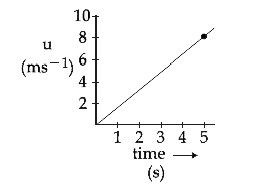consider a head on collision between two particles of masses m1andm2. The initial speeds of the particles are u1andu2 in the same direction. The collision starts at t=0 and the particles interact for a time interval △t. during the collision the speed of the first particle varies as
v(t)=u1+t/ t(v1−u1) Find the speed of the second particle as as function of time during the collision.Solution in Tamil
Using lw of conservation of momentum m1u1+m2u2=m1v(t)+m2v1
where v=speed of 2nd particle during collision
→m1u1+m2u2
1=m_1u_1+m_1.(t//_\)(v_1-u_1)+m_2v^1<br>rarr (m_2u_20/m_2=m_1/m_2(t//_\t)(v_1-u_1)+v^1<br>: v^1=u_1-m_1/m_2 t//_\t(v_1-u_1)
Topper's Solved these Questions
Similar Questions
The centre of mass of a system of particles is at the origin. It follows that:
02:01View SolutionAn aluminium vessel of mass 0.5kg contains 0.2kg of water at 20∘C A block of iron of mass 0.2kgat100∘C is gently put into the water .Find the equilibrium temperature of the mixture, Specific heat capacities of aluminium , iron and water are 910Jkg−1K−1470Jkg−1K−1and4200Jkg−1K−1 respectively
03:43View SolutionFind the accelerationof the moon with respect to the eath from the following data, Distance between the earth and the moon =3.85×105 km and the time taken by the moon to complete one revolution around the earth =27.3days
01:43View SolutionA particle P moving with speed v undergoes a head -on elastic collision with another particle Q of identical mass but at rest. After the collision the collision
04:30View Solutionm1 तथा m2 द्रव्यमान वाले दो कणों में सीधी प्रत्यास्थ टक्कर होती है। कणों की प्रारंभिक चा्ले u1 तथा u2 एक ही दिशा में है। टक्कर t=0 पर प्रारंभ होती है तथा Δt समयांतराल तक होती रहती है। टक्कर के दौरान प्रथम कण की चाल नीचे दिए गए समीकरण के अनुसार परिवर्तित होती है,
v(t)=u1+tΔt(v1−u1)
टक्कर के दौरान दूसरे कण की चाल समय के फलन के रूप में जात कीजिए।02:07View SolutionTwo particles of masses m_1 , m_2 move with initial velocities u_1 and u_2 . On collision, one of the particles gets excited to higher level, after absorbing energy ε. If final velocities of particles be v_1 and v_2 , then v must have
05:11View SolutionAfter perfectly inelastic collision between two identical particles moving with same speed in different directions, the speed of the particles become half the initial speed. Find the angle between the two before collision.
03:52View SolutionThe speed verses time graph for a particle is shown in the figure. The distance travelled (in m) by the particle during the time interval t = 0 to t = 5 s will be __________
06:00View Solutionm_1 And m_2 The two objects of mass are particles, respectively u_1 And u_2 Running at initial speed. A particle as a result of collision epsilon The amount of energy is absorbed and transferred to higher energy levels. The final velocity of the two particles v_1 Oh v_2 If,
03:36View SolutionThe acceleration of a particle varies with time t as a=t^(2)+t+2 where t is in seconds. The particle starts with an initial velocity v-3m/s at t=0. find the velocity of the particle at the end of 5s.
02:43View SolutionTwo particles are simultaneously projected in opposite directions from a given point, where the gravitational acceleration g is the same. If u_1 and u_2 Their initial speed is time t after which their velocities will be perpendicular to each other.
View SolutionA particle is kept at rest at the origin. A constant force →F starts acting on it at t=0. Find the speed of the particle at time t.
View SolutionThe speed verses time graph for a particle is shown in the figure. The distance travelled (in m) by the particle during the time interval t = 0 to t = 5 s will be __________
 View Solution
View SolutionAfter perfectly inelastic collision between two identical particles moving with same speed in different directions, the speed of the combined particle becomes half the initial speed of either particle. The angle between the velocities of the two before collision is
View SolutionAfter perfectly inelastic collision between two identical particles moving with same speed in different directions, the speed of the combined particle becomes half the initial speed of either particle. The angle between the velocities of the two before collision is
View SolutionAfter perfectly inelastic collision between two identical particles moving with same speed in different directions, the spee of the combined particle becomes half the initial speed of either particle. The angle between the velocities of the two before collision is
06:13View Solution

